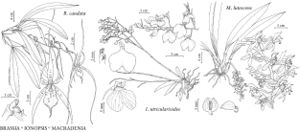Tolumnia bahamensis
Orchidee (Hamburg) 37: 59. 1986.
Plants to 12 cm (excluding inflorescence). Leaves semiterete 3–10 × 0.4–1 cm. Inflorescences 1–4, erect, to 50 cm, side branches few or none, to 4.5 cm; bracts 2–6 mm. Flowers white with redbrown spots at bases of perianth parts; sepals spatulate, 4–6 × 1–2 mm, apex apiculate; lateral sepals connate to 3/4 length; petals spatulate to pandurate, 5 × 2 mm, apex rounded to retuse, often apiculate; lip with large redbrown spots near yellow callus, 8–12 × 8–13 mm, middle lobe about 1/3 wider than combined lateral lobes, apex retuse-apiculate, isthmus 0.2–0.4 cm wide with serrate margins; callus with 2 sets of tuberculate processes, 3 proximal, broader, 2 distal, smaller; column whitish to pale lavender with yellow base and white to rose-purple column wings 5–6 mm. Capsules 1.5 cm.
Phenology: Flowering Apr–Jun.
Habitat: Terrestrial or epiphytic on shrubs and scrub trees in dry thickets
Elevation: 0–10 m
Distribution
Fla., West Indies (Bahamas)
Discussion
Tolumnia bahamensis has been regarded by some authors as a synonym or variety of T. variegata (D. S. Correll 1950; C. L. Withner 1980). Flower morphology helps little in the T. variegata complex (J. D. Ackerman and M. Galarza-Pérez 1991); T. bahamensis differs, however, by being a tetraploid (84 chromosomes) and having semiterete leaves. These features also exist in T. sylvestris (G. J. Braem 1986b), a species of eastern Cuba generally found in high elevation pine forests, a habitat somewhat different from that of either Florida or the Bahamas. Whether or not T. sylvestris and T. bahamensis are conspecific awaits further studies.
Selected References
None.
Lower Taxa
"broader" is not a number."/4" is not declared as a valid unit of measurement for this property.
